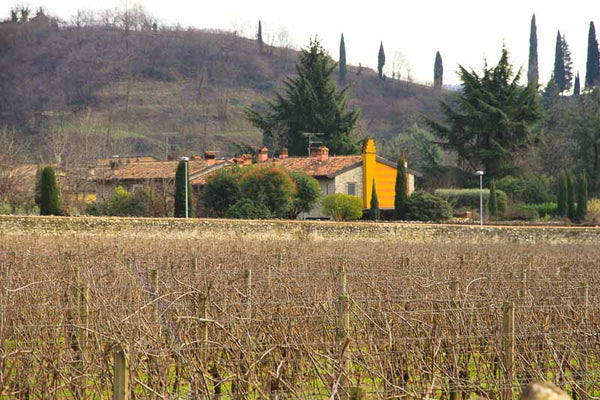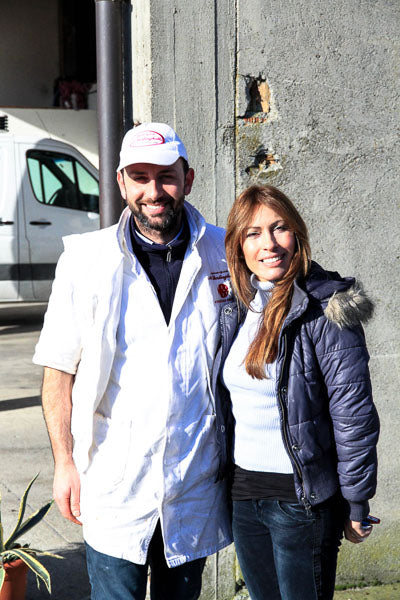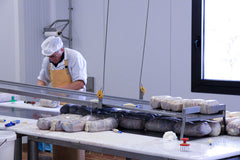By: Sara Grazia
The next few months will be heaven for many homemaking salami enthusiasts. The weather down south has finally gotten grey and miserable, the ideal time to get your casings ordered and soaking, your fillers cleaned, polished and placed front and centre on your table.
If you’ve not started preparing for this year’s salami making season, don’t panic, it’s not too late, there is plenty of curing time still to come. For those of you that have made some salami, why not make some more? You’ve made the family recipe, why not experiment with a few kilograms of something exciting just for yourself!
Earlier this year, while many of you were enjoying the summer sunshine, I was rugged up in fleece, mittens and everything else I could find to keep me from freezing as I travelled around Italy working with some of the best artisan producers in the country.

Every year that I do this it is an exciting time for me; however this year just seemed more inspiring than ever. I learned about, and got the opportunity to experiment with, new techniques and got creative with new ingredients. It was how I imagine a six year old feeling on their first ever visit to Disneyland.
So much happened in such a short time, let me tell you about my visit to Berlingo.
This is a truly inspirational story. I met signor Luigi on a previous trip to Italy. I went back to see him again this year to find that in the last 12 months he has extended his processing plant, added a salami bar and is one of the most sought after boutique producers in the Northern provinces.

Like many of you, and very close to my own background, signor Luigi was brought up making fresh produce at home every year with his family. After his studies he went on to create what is now becoming one of Italy’s highest sort after boutique salami and small goods producer. In this rural setting, he produces everything you could possibly imagine that could be created from one animal.
The carcasses are delivered early in the morning, they’re hung in a foyer (which resembles something like an airlock in Sci-Fi movie), and here they are gutted and drained. Someone will be there to collect all the different organs and the blood and takes them away, cleans them and gets them ready for processing. Nothing goes to waste!
After the carcass has been cleaned it is then moved into the main production area. Here the meat is weighed and cut up into all the different cuts that will be used for the array of salami and cured meats that are to be made. This room looked more like a Hollywood movie torture chamber with all sorts of manual and electric cutting machines hanging from the ceiling and fixed to the walls. For me this is where my ‘Disneyland’ moment started. Seeing how respectfully and carefully the animal was treated, and the precision used to dissect the animal in such a meticulous way as to not waste any or damage any of the quality cuts.
One of Italy’s biggest exports is prosciutto, every production house no matter how big or small, is totally focused on producing quality prosciutto. This is equivalent to owning a gold mine to Italian producers. Once the legs have been removed the rest of the animal is taken apart quickly and put into individual crates ready for processing. The meat for the salami is taken away ready for mincing; the neck (capocollo) is taken to another area in the factory where master craftsman are ready and waiting to prepare the meats. This process continues for each and every cut of meat.


In these boutique manufacturing places you will find that each processing area has its own set of skilled producers. The team making the capocollo doesn’t make the salami, the salami makers don’t produce the prosciutto and so on. Each production process is a skilled craft.
With all the cuts sent off to various areas, our tour continues on. Tucked away in a corridor was what I initially thought was a cleaning cupboard, it was small and pokey, barely large enough for a fully grown person to fit. It actually turned out to be the recipe mixing room. In true Italian style, no one except signor Luigi and a few select staff were aloud in here to prepare and mix the recipes.
Recipes are blended and then taken off to the various areas to either be mixed in with the minced meat for the salami or rubbed onto the big muscle meats such as bresaola and pancetta. These recipes are so prized that not even the master craftsman preparing the meats know the particulars of the ingredients and quantities.
With all the meats taken off to their various zones, it was time to go and visit some of these masters of meat. Each preparation zone housed different types of equipment that were specific and required for each particular process. In the room where the pancetta and capocollo were being made, the room was lined with benches full of spindles of salami twine, butchers hooks, curing wraps and all sorts of trinkets and gadgets to aid in the production of the perfect Italian cured meat.


Down the centre of the room was a long island bench where five or six elderly Italian men were working away, chatting and laughing while they worked. At the end of the bench all the meats were rolled into a large bucket where it will be wheeled into the adjoining meat room ready for salting.
Further down the hall, salami was being prepared. This is a very meticulous process, with each stage being carried out in separate rooms.

Once all the meats had been prepared wrapped or filled, tied and netted, they are taken away to the drying rooms. Each type of meat has its own specific drying room, each monitored with varying temperatures and humidity levels. Some lovely and warm, others very chilled and one or two equivalent to the outside temperature.



Each drying room is heavily packed with racks brimming with thousands of kilos of produce. The aromas alone wanted you make a run for the closest rack, pull down a salami and start eating. In the drying room a little further down the hall was the prosciutto room... my own personal piece of paradise.


With my senses overloaded with phenomenal fragrances and sights it was time to head back upstairs with for a little tasting. It true Italian style, our little tasting turned more into lunch. We went through a couple of salami with some locally made bread and a bottle of wine. The salami was delicious, the consistency was lovely, and the meat was tightly compacted with the hint of crushed spices, the colour, and a beautiful crimson.




It was sad to say goodbye after such an amazing morning with signor Luigi, the sadness was softened though when he gifted me with a stick of a traditional northern style salami, Felino - a delicious salami recipe I now produce myself at my Sausage HQ!
























← Older Post Newer Post →
0 comments